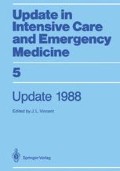Abstract
Hypoxemic or hypercapnic respiratory failure has traditionally been the main cause of mechanical ventilation. Although respiratory failure is a frequent complication of shock, the use of mechanical ventilation has been instituted only when severe gas exchange abnormalities occurred. We maintain that mechanical ventilation should be instituted early in the course of shock for two reasons:
-
1
to put the respiratory muscles at rest, and thereby avoid respiratory muscle fatigue, and
-
2
to free blood from the working respiratory muscles. The blood can, in turn, supply vital organs.
Access this chapter
Tax calculation will be finalised at checkout
Purchases are for personal use only
Preview
Unable to display preview. Download preview PDF.
References
Aubier M, Trippenbach T, Roussos Ch (1981) Respiratory muscle fatigue during cardiogenic shock. J Appl Physiol 51:499–508.
Hussain SNA, Simkus G, Roussos Ch (1985) Ventilatory muscle fatigue, the cause of respiratory failure in septic shock. J Appl Physiol 58:2033–2040.
Viires N, Sillye G, Aubier M, Rassidakis A, Roussos Ch (1983) Regional bood flow distribution in dog during induced hypotension and low cardiac output. Spontaneous breathing versus artificial ventilation. J Clin Invest 72:935–947.
Aubier M, Viires N, Sillye G, Mozes R, Roussos Ch (1982) Respiratory muscle contribution to lactic acidosis in low cardiac output. Am Rev Respir Dis 126:642–652.
Hussain S, Roussos Ch (1985) Distribution of respiratory muscle and organ blood flow during endotoxin shock in dogs. J Appl Physiol 59:1802–1808.
Peretz DI, McGregor M, Dossetor JB (1964) Lactic acidosis: a clinically significant aspect of shock. Can Med Assoc J 90:673–675.
Vincent JL, Dufaye P, Berré J, Leeman M, Degaute JP, Kahn RJ (1983) Serial lactate determinations during circulatory shock. Crit Care Med 11:449–451.
Blair E, Cowley A, Tait MK (1965) Refractory septic shock in man: role of lactate and pyruvate metabolism in prognosis. Ann Surg 31:537–540.
Field S, Kelly SM, Macklem PT (1982) The oxygen cost of breathing in patients with cardiorespiratory disease. Am Rev Respir Dis 126:9–13.
Burzstein S, Taitelman U, DeMyttenaere S, et al (1978) Reduced oxygen consumption in catabolic states with mechanical ventilation. Crit Care Med 6:162–168.
Bjork VO, Grenvik A, Holmdahl MH, Westerholm CJ (1964) Cardiac output and oxygen consumption during respiratory treatment. Acta Anaesth Scand (supp) 15:158–160.
Robotham JL, Scharf SM (1983) Effects of positive and negative pressure ventilation on cardiac performance. Clin Chest Med 4:161–187.
Luce JM (1984) The cardiovascular effects of mechanical ventilation and positive end expiratory pressure. JAMA 252:807–811.
Ashbaugh CG, Petty TL (1973) Positive end-expiratory pressure physiology, indications and contraindications. J Thor Cardiovas Surg 65:165.
Qvist J, Pontoppidan H, Wilson RS, Lowenstein E, Laver MB (1975) Hemodynamic responses to mechanical ventilation with PEEP. Anaesthesiology 42:45–55.
Grindlinger GA, Manny J, Justice R, Dunham, Shepro D, Heshtman HB (1979) Presence of negative inotropic agents in caning plasma during positive end-expiratory pressure. Circ Res 45:460–467.
Click G, Weschler AS, Epstein SE (1969) Reflex cardiovascular depression produced by stimulation of pulmonary stretch receptors in the dog. J Clin Invest 48:467–473.
Marthru M (1985) Mechanical breath; non-pharmacologic support for a failing heart? Chest 85:1.
Ellman H, Dembin H (1982) Lack of adverse hemodynamic effects of PEEP in patients with acute respiratory failure. Crit Care Med 10:706–711.
Calvin JE, Driedser AA, Sibbald WJ (1981) Positive end-expiratory pressure does not depress left ventricular function in patients with edema. Am Rev Respir Dis 124:121–128.
Beach T, Milien E, Grenvik A (1973) Hemodynamic response to discontinuation of mechanical ventilation. Crit Care Med 1:85–90.
Pinsky MR, Summer WR (1983) Cardiac augmentation by phasic high intrathoracic pressure support in man. Chest 84:370–375.
Pinsky MR, Summer WR, Wise RH, et al (1983) Augmentation of cardiac function by elevation of intrathoracic pressure. J Appl Physiol 54:950–955.
Prewitt RM, Oppenheimer L, Sutherland JB, Wood LDH (1981) Effect of positive end-expiratory pressure on left ventricular mechanics in patients with hypoxemic respiratory failure. Anaesthesiology 55:409–415.
Crace MR, Greenham DM (1982) Cardiac performance in response to PEEP in patients with cardiac dysfunction. Crit Care Med 10:358–360.
Criley JM, Balfuss Ah, Vissel GL (1976) Cough-induced cardiac compression: self-administered form of cardiopulmonary resuscitation. JAMA 236:1246–1250.
Chandra N, Weisfeldt ML, Tsitlik J, et al (1981) Augmentation of carotid flow during cardiopulmonary resuscitation by ventilation at high airway pressure with chest compression. Am J Cardiol 48:1053–1063.
Rosborough JP, Nieman JT, Griley JM, et al (1981) Lower abdominal compression with synchronized ventilation; a CPR modality. Circulation 64 (suppl 4):303 (Abstract).
Niemann JT, Rosborough JP, Niskanen RA, Criley JM (1984) Circulatory support during cardiac arrest using a pneumatic vest and abdominal binder with simultaneous high-pressure airway inflation. Ann Emerg Med 13:270–277.
Passerini L, Wise RA, Roussos Ch (1985) Maintenance of circulation during CPR with mechanical ventilation. Clin Invest Med 8:R164.
Editor information
Editors and Affiliations
Rights and permissions
Copyright information
© 1988 Springer-Verlag Berlin Heidelberg
About this chapter
Cite this chapter
Roussos, C. (1988). Mechanical Ventilation in Cardiogenic and Septic Shock. In: Vincent, J.L. (eds) Update 1988. Update in Intensive Care and Emergency Medicine, vol 5. Springer, Berlin, Heidelberg. https://doi.org/10.1007/978-3-642-83392-2_92
Download citation
DOI: https://doi.org/10.1007/978-3-642-83392-2_92
Publisher Name: Springer, Berlin, Heidelberg
Print ISBN: 978-3-540-18981-7
Online ISBN: 978-3-642-83392-2
eBook Packages: Springer Book Archive

